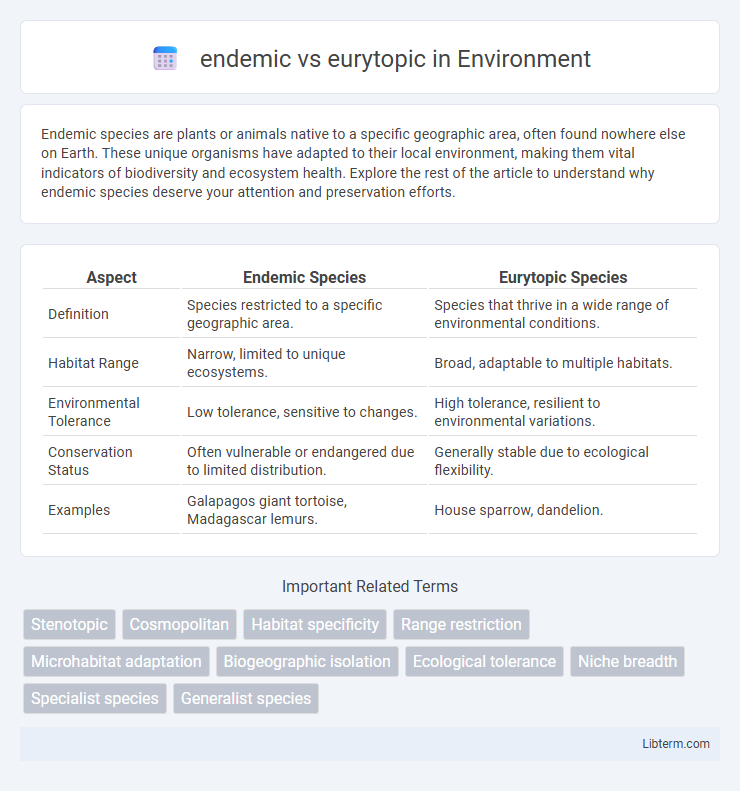Endemic species are plants or animals native to a specific geographic area, often found nowhere else on Earth. These unique organisms have adapted to their local environment, making them vital indicators of biodiversity and ecosystem health. Explore the rest of the article to understand why endemic species deserve your attention and preservation efforts.
Table of Comparison
| Aspect | Endemic Species | Eurytopic Species |
|---|---|---|
| Definition | Species restricted to a specific geographic area. | Species that thrive in a wide range of environmental conditions. |
| Habitat Range | Narrow, limited to unique ecosystems. | Broad, adaptable to multiple habitats. |
| Environmental Tolerance | Low tolerance, sensitive to changes. | High tolerance, resilient to environmental variations. |
| Conservation Status | Often vulnerable or endangered due to limited distribution. | Generally stable due to ecological flexibility. |
| Examples | Galapagos giant tortoise, Madagascar lemurs. | House sparrow, dandelion. |
Understanding Endemic and Eurytopic Species
Endemic species are organisms restricted to a specific geographic area, often due to specialized habitat requirements or evolutionary history, making them vulnerable to environmental changes and habitat loss. Eurytopic species exhibit broad ecological tolerance, thriving in diverse environments and demonstrating adaptive versatility across various habitats and climatic conditions. Understanding these distinctions highlights the ecological significance of endemic species for biodiversity conservation and the resilience of eurytopic species in ecosystem stability.
Defining Endemic Species: Unique to a Region
Endemic species are organisms that exist exclusively within a specific geographical area, often due to unique environmental conditions and evolutionary history. Unlike eurytopic species, which thrive across diverse habitats and wide ecological ranges, endemic species have a limited distribution, making them more vulnerable to habitat loss and environmental changes. Understanding the conservation needs of endemic species is crucial for protecting biodiversity hotspots and maintaining ecological balance.
Eurytopic Species: Masters of Adaptation
Eurytopic species exhibit remarkable ecological plasticity, thriving across diverse habitats and environmental conditions due to their broad tolerance ranges. Their adaptability to varied temperature, moisture, and soil parameters enhances ecosystem stability and resilience. This ecological versatility contrasts sharply with endemic species, which have narrow habitat requirements and limited geographic distribution.
Key Differences Between Endemic and Eurytopic Organisms
Endemic organisms are species restricted to a specific geographic region or habitat, which limits their distribution and often makes them vulnerable to environmental changes. Eurytopic organisms exhibit a wide ecological tolerance and can thrive in diverse habitats and environmental conditions across multiple regions. Key differences include endemic species' narrow habitat specialization and limited distribution, contrasted with eurytopic species' broad habitat adaptability and extensive geographic range.
Examples of Endemic Species Around the World
Endemic species such as the Galapagos tortoise in the Galapagos Islands, the lemurs of Madagascar, and the kiwi bird native to New Zealand illustrate organisms restricted to specific geographic regions. In contrast, eurytopic species like the raccoon exhibit adaptability to a wide range of environmental conditions and habitats globally. Understanding these distinctions helps in biodiversity conservation and habitat management strategies.
Notable Eurytopic Species and Their Habitats
Notable eurytopic species such as the white-tailed deer (Odocoileus virginianus) and the common raccoon (Procyon lotor) thrive in diverse habitats ranging from forests and wetlands to urban areas and agricultural lands. These species demonstrate high ecological plasticity, enabling them to adapt to varied environmental conditions and resource availabilities across their wide geographical distribution. Their eurytopic nature contrasts sharply with endemic species, which are restricted to specialized or localized habitats with limited distribution.
Ecological Roles and Importance of Endemic Species
Endemic species play a crucial role in maintaining the ecological balance by contributing to unique biodiversity and specialized habitats, often supporting intricate food webs and ecosystem services exclusive to their regions. Eurytopic species, characterized by their adaptability to diverse environments, contribute to ecosystem resilience but lack the localized ecological specificity found in endemic species. The preservation of endemic species is vital for sustaining genetic diversity and ensuring the stability of ecosystems that cannot be replicated by widely distributed eurytopic species.
Survival Strategies of Eurytopic Species
Eurytopic species exhibit high ecological plasticity, enabling survival across diverse habitats and fluctuating environmental conditions through adaptive foraging and reproductive strategies. Their broad niche breadth minimizes competition by exploiting various resources and microhabitats, enhancing resilience to habitat disturbances and climate variability. In contrast, endemic species possess specialized adaptations restricting them to specific environments, making eurytopic survival strategies advantageous for widespread distribution and long-term persistence.
Conservation Challenges for Endemic vs Eurytopic Species
Endemic species face heightened conservation challenges due to their limited geographic ranges, making them more susceptible to habitat loss, climate change, and localized threats. Eurytopic species, with broader ecological tolerances and distributions, often exhibit greater resilience but can still be impacted by widespread environmental changes and habitat fragmentation. Effective conservation strategies must tailor protection efforts to the specific ecological requirements and vulnerabilities of endemic populations while maintaining landscape connectivity to support eurytopic species' adaptability.
The Future of Biodiversity: Endemics and Eurytopics Compared
Endemic species, restricted to specific geographic regions, face heightened vulnerability to habitat loss and climate change, making their conservation critical for preserving biodiversity hotspots. Eurytopic species, adaptable to a wide range of environmental conditions, often serve as ecological generalists and indicators of ecosystem resilience. The future of biodiversity depends on balancing protection efforts for endemics with the management of eurytopics to maintain ecological stability and adaptability.
endemic Infographic

 libterm.com
libterm.com